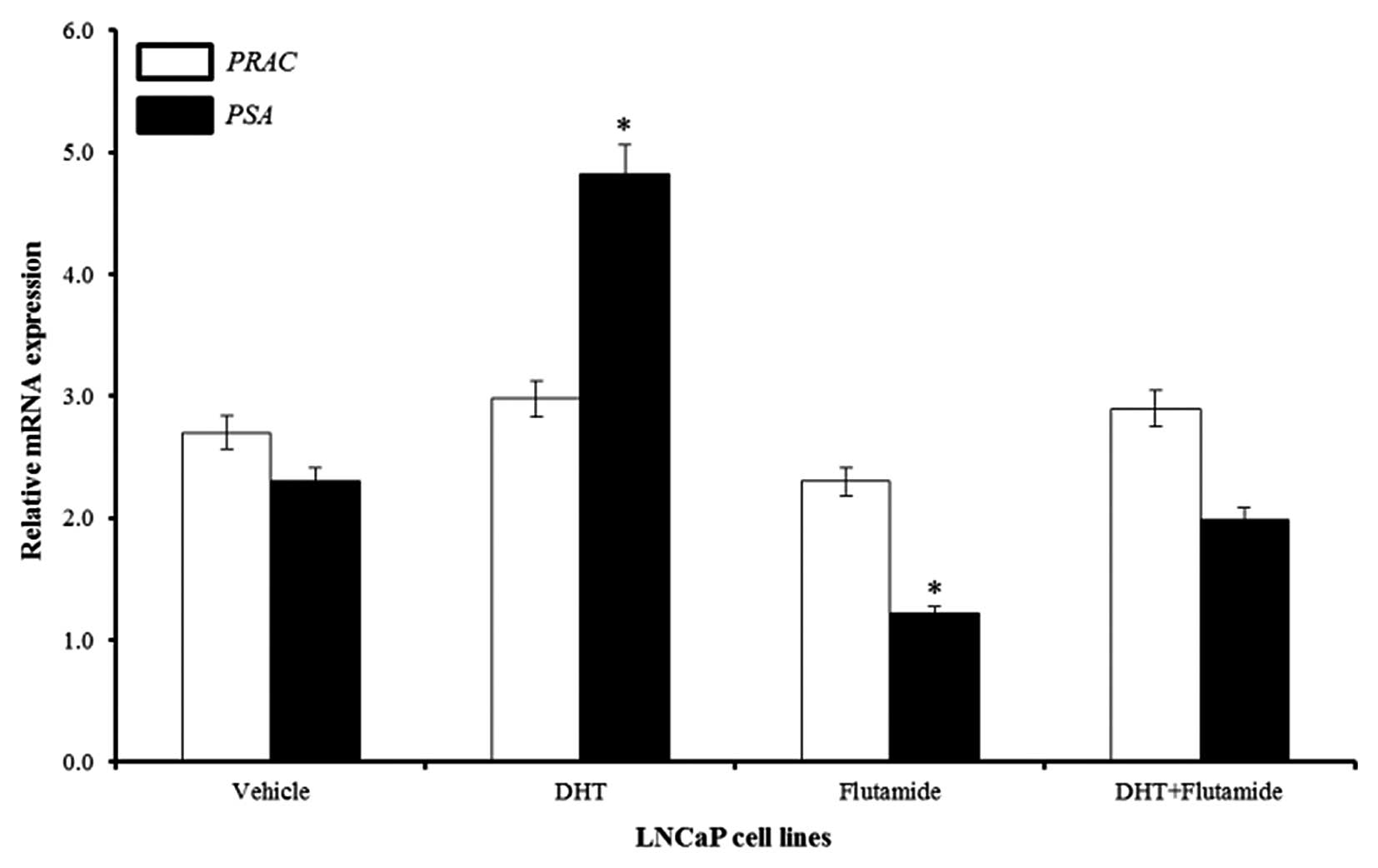|
1.
|
Pang ST, Fang X, Valdman A, Norstedt G,
Pousette A, Egevad L and Ekman P: Expression of ezrin in prostatic
intraepithelial neoplasia. Urology. 63:609–612. 2004. View Article : Google Scholar : PubMed/NCBI
|
|
2.
|
Obinata D, Takayama K, Urano T, et al:
Oct1 regulates cell growth of LNCaP cells and is a
prognostic factor for prostate cancer. Int J Cancer. 130:1021–1028.
2012. View Article : Google Scholar
|
|
3.
|
Garnick MB and Fair WR: Combating prostate
cancer. Sci Am. 279:74–83. 1998. View Article : Google Scholar : PubMed/NCBI
|
|
4.
|
Gelmann EP: Molecular biology of the
androgen receptor. J Clin Oncol. 20:3001–3015. 2002. View Article : Google Scholar : PubMed/NCBI
|
|
5.
|
Pang ST, Dillner K, Wu X, Pousette A,
Norstedt G and Flores-Morales A: Gene expression profiling of
androgen deficiency predicts a pathway of prostate apoptosis that
involves genes related to oxidative stress. Endocrinology.
143:4897–4906. 2002. View Article : Google Scholar : PubMed/NCBI
|
|
6.
|
Sharma S, Kelly TK and Jones PA:
Epigenetics in cancer. Carcinogenesis. 31:27–36. 2010. View Article : Google Scholar
|
|
7.
|
Feinberg AP, Ohlsson R and Henikoff S: The
epigenetic progenitor origin of human cancer. Nat Rev Genet.
7:21–33. 2006. View
Article : Google Scholar : PubMed/NCBI
|
|
8.
|
Lin X, Tascilar M, Lee WH, et al:
GSTP1 CpG island hypermethylation is responsible for the
absence of GSTP1 expression in human prostate cancer cells. Am J
Pathol. 159:1815–1826. 2001. View Article : Google Scholar
|
|
9.
|
Perry AS, Foley R, Woodson K and Lawler M:
The emerging roles of DNA methylation in the clinical management of
prostate cancer. Endocr Relat Cancer. 13:357–377. 2006. View Article : Google Scholar : PubMed/NCBI
|
|
10.
|
Hanson JA, Gillespie JW, Grover A, et al:
Gene promoter methylation in prostate tumor-associated stromal
cells. J Natl Cancer Inst. 98:255–261. 2006. View Article : Google Scholar : PubMed/NCBI
|
|
11.
|
Singal R, van Wert J and Bashambu M:
Cytosine methylation represses glutathione S-transferase P1
(GSTP1) gene expression in human prostate cancer cells.
Cancer Res. 61:4820–4826. 2001.PubMed/NCBI
|
|
12.
|
Okubo K and Matsubara K: Complementary DNA
sequence (EST) collections and the expression information of the
human genome. FEBS Lett. 403:225–229. 1997. View Article : Google Scholar : PubMed/NCBI
|
|
13.
|
Burke J, Wang H, Hide W and Davison DB:
Alternative gene form discovery and candidate gene selection from
gene indexing projects. Genome Res. 8:276–290. 1998. View Article : Google Scholar : PubMed/NCBI
|
|
14.
|
Liu XF, Olsson P, Wolfgang CD, Bera TK,
Duray P, Lee B and Pastan I: PRAC: A novel small nuclear
protein that is specifically expressed in human prostate and colon.
Prostate. 47:125–131. 2001. View Article : Google Scholar
|
|
15.
|
Rozen S and Skaletsky H: Primer3 on the
WWW for general users and for biologist programmers. Methods Mol
Biol. 132:365–386. 2000.PubMed/NCBI
|
|
16.
|
Li LC and Dahiya R: MethPrimer: designing
primers for methylation PCRs. Bioinformatics. 18:1427–1431. 2002.
View Article : Google Scholar : PubMed/NCBI
|
|
17.
|
Andreoiu M and Cheng L: Multifocal
prostate cancer: biologic, prognostic, and therapeutic
implications. Hum Pathol. 41:781–793. 2010. View Article : Google Scholar : PubMed/NCBI
|
|
18.
|
Visakorpi T, Hyytinen E, Koivisto P, et
al: In vivo amplification of the androgen receptor gene and
progression of human prostate cancer. Nat Genet. 9:401–406. 1995.
View Article : Google Scholar
|
|
19.
|
Montgomery BT, Young CY, Bilhartz DL,
Andrews PE, Prescott JL, Thompson NF and Tindall DJ: Hormonal
regulation of prostate-specific antigen (PSA) glycoprotein in the
human prostatic adenocarcinoma cell line, LNCaP. Prostate.
21:63–73. 1992. View Article : Google Scholar : PubMed/NCBI
|
|
20.
|
Lee C, Sutkowski DM, Sensibar JA, et al:
Regulation of proliferation and production of prostate-specific
antigen in androgen-sensitive prostatic cancer cells, LNCaP, by
dihydrotestosterone. Endocrinology. 136:796–803. 1995.PubMed/NCBI
|
|
21.
|
Olsson P, Motegi A, Bera TK, Lee B and
Pastan I: PRAC2: a new gene expressed in human prostate and
prostate cancer. Prostate. 56:123–130. 2003. View Article : Google Scholar
|
|
22.
|
Sreenath T, Orosz A, Fujita K and
Bieberich CJ: Androgen-independent expression of hoxb-13 in
the mouse prostate. Prostate. 41:203–207. 1999. View Article : Google Scholar
|
|
23.
|
Jones PA and Taylor SM: Cellular
differentiation, cytidine analogs and DNA methylation. Cell.
20:85–93. 1980. View Article : Google Scholar : PubMed/NCBI
|
|
24.
|
Bender CM, Gonzalgo ML, Gonzales FA,
Nguyen CT, Robertson KD and Jones PA: Roles of cell division and
gene transcription in the methylation of CpG islands. Mol Cell
Biol. 19:6690–6698. 1999.PubMed/NCBI
|
|
25.
|
Chiam K, Centenera MM, Butler LM, Tilley
WD and Bianco-Miotto T: GSTP1 DNA methylation and expression
status is indicative of 5-aza-2′-deoxycytidine efficacy in human
prostate cancer cells. PLoS One. 6:e256342011. View Article : Google Scholar : PubMed/NCBI
|
|
26.
|
Cheng L, Bostwick DG, Li G, Wang Q, Hu N,
Vortmeyer AO and Zhuang Z: Allelic imbalance in the clonal
evolution of prostate carcinoma. Cancer. 85:2017–2022. 1999.
View Article : Google Scholar : PubMed/NCBI
|
|
27.
|
Uchida T, Wang C, Sato T, et al:
BRCA1 gene mutation and loss of heterozygosity on chromosome
17q21 in primary prostate cancer. Int J Cancer. 84:19–23. 1999.
View Article : Google Scholar
|













